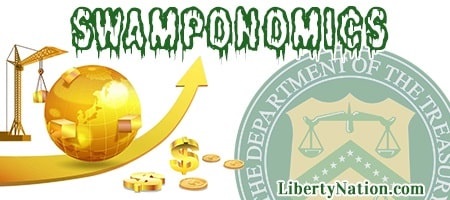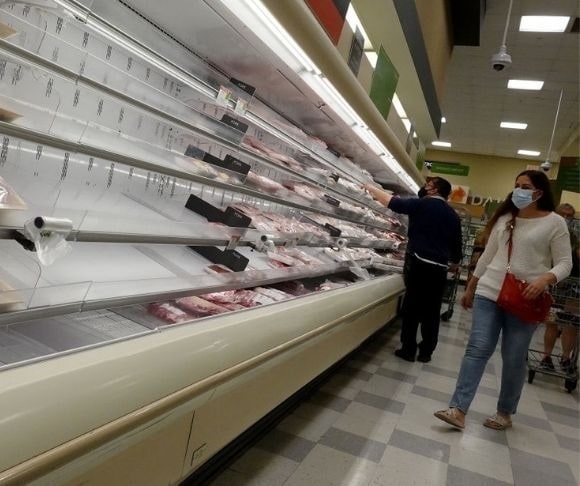Are the American people losing faith in the United States economy? Despite a rebounding labor market and one stellar gross domestic product (GDP) reading in the fourth quarter, consumers are not entirely confident in what is transpiring in the post-pandemic recovery, no matter what emanates from the collective minds at the White House. As Liberty Nation’s Sarah Cowgill says, “Politics is perception.”
The University of Michigan released its final reading of the January Consumer Sentiment Index, and it declined to a decade low of 67.2, down from 70.6 in December. The market had forecast a figure of 68.7. But that was not all from the much-anticipated snapshot into the mind of the everyday consumer.
 January’s Consumer Expectations Index fell to 64.1, down from 68.3 in the previous. Likewise, the Current Conditions measurement eased to 72, down from 74.2. On the cost-of-living front, U.S. consumers believe price inflation will remain at 4.9% over the next year, while the five-year outlook climbed to 3.1%.
January’s Consumer Expectations Index fell to 64.1, down from 68.3 in the previous. Likewise, the Current Conditions measurement eased to 72, down from 74.2. On the cost-of-living front, U.S. consumers believe price inflation will remain at 4.9% over the next year, while the five-year outlook climbed to 3.1%.
Richard Curtin, the university’s chief economist, explained that the Delta and Omicron variants were the dominant contributing factors to waning sentiment, with supply chains and rising prices functioning as the other components to slumping faith in Bidenomics.
“Consumers may misinterpret the Fed’s policy moves to slow the economy as part of the problem rather than part of the solution,” he said in a statement. “The danger is that consumers may overreact to these tiny nudges, especially given the uncertainties about the coronavirus and other heightened geopolitical risks. Clear policy communication is insufficient if it does not also advance consumers’ understanding of the economic trade-offs involved and their plans to actively alleviate any undue harm.”
With the power brokers in the nation’s capital, from the Oval Office to the Federal Reserve, getting it wrong on everything over the last year, it might not be too surprising that people do not trust public policymakers in this environment. Who would with this type of putrid track record?
What’s the Deal with Natural Gas?
In Jerry Seinfeld’s voice, here is a question: What’s the deal with natural gas prices these days? The energy commodity has been the top-performing asset so far this year, soaring 68% in the first month of 2022. The next closest assets were diesel (+19.9%), crude oil (+15.2%), orange juice (+10.4%), and soybeans (+9%). The so-called bridge fuel has been on a tear for most of January, with a little bit of reprieve before this month’s massive snowstorm that blanketed 88 million Americans and many parts of Canada.

(Photo by Paul Hennessy/SOPA Images/LightRocket via Getty Images)
Indeed, many elements are adding to its meteoric ascent. Tensions at the Ukraine-Russia border have been on the minds of many investors since Russia is one of the world’s largest exports of oil and gas, Europe is in desperate need of energy, and Ukraine is a critical transit route in Eastern Europe. Old Man Winter, making everyone miserable in the Northern Hemisphere, has imbibed North American and European stockpiles, making a mess of himself as he gorges on our souls. The U.S. Energy Information Administration (EIA) reported another domestic withdrawal of more than 200 billion cubic feet, creating a tight situation for the country.
A notable development in energy markets has been the enormous rally toward the end of contracts. For 13 of the last 15 months, expiring natural gas futures contracts have reveled in the eye-popping gains, with February prices climbing more than 40% in a single session. The March contract added 10% during the Jan. 28 session on the New York Mercantile Exchange. With weather models suggesting cold temperatures could last throughout February, the fundamentals are supporting the commodity.
If you are a bull, you have made a killing. If you are a bear, well, the market offers its sympathies.
Jerome Powell Wags the Finger
The Federal Open Market Committee (FOMC) did not raise interest rates during its January policy meeting. However, the Federal Reserve signaled that liftoff is soon, with the first rate hike in the post-crisis economy potentially scheduled for March. In a separate statement, the Fed revealed that it projects that the more than $8 trillion balance sheet could be reduced starting after the first move on the fed funds rate, which is in the range of 0% and 0.25%.
In fact, the Fed “is of a mind” to pull the trigger on back-to-back rate hikes. How much Powell and Co. could increase the benchmark is unclear. According to the CME Group FedWatch tool, the market is penciling in a 25-basis-point jump, while Wall Street is also predicting multiple 25-basis-point boosts over the next year.
 At this point, the Eccles Building is more concerned about the broader economy, the labor market, and inflation than the financial markets. Nevertheless, the equities arena has been in a selloff mode for much of January, enduring the worst month of selling since March 2020. With a fear of the Fed no longer supplying easy money to growth stocks and margin-addicted traders, investors have panicked and turned to Treasurys to seek shelter from the red ink hailing from the Fed apotheosis.
At this point, the Eccles Building is more concerned about the broader economy, the labor market, and inflation than the financial markets. Nevertheless, the equities arena has been in a selloff mode for much of January, enduring the worst month of selling since March 2020. With a fear of the Fed no longer supplying easy money to growth stocks and margin-addicted traders, investors have panicked and turned to Treasurys to seek shelter from the red ink hailing from the Fed apotheosis.
“Apparently, the recent market rout hasn’t given cold feet to Powell and the Fed members, meaning that they are ready to take on more losses on the equities front to get inflation under control,” said Ipek Ozkardeskaya, a senior analyst at Swissquote. “After all, one leg of their dual mandate goal is price stability – and the other is a healthy labour market. The mandate is not to offer the market a sustained and a powerful rally, although a full-blast financial crisis is an undesired side-effect.”
Considering that the institution’s favorite inflation gauge – the personal consumption expenditure (PCE) price index – climbed to its highest level since 1983 in December, Powell will need to rein in Powellflation, even if this risks the financial markets further hemorrhaging on The Street.
~ Read more from Andrew Moran.




